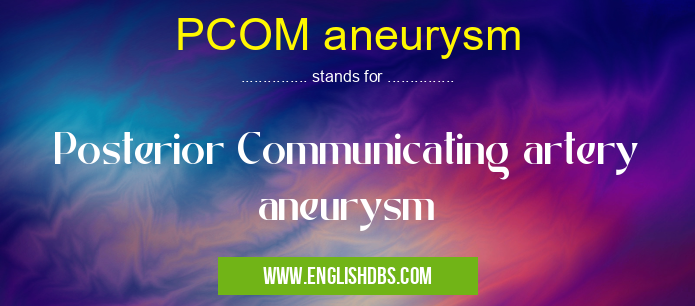What does PCOM ANEURYSM mean in BRITISH MEDICINE
PCOM aneurysm stands for Posterior Communicating artery aneurysm. It is a type of cerebral aneurysm that occurs at the junction of the posterior communicating artery and the internal carotid artery. PCOM aneurysms are relatively common, accounting for approximately 15-20% of all intracranial aneurysms.

PCOM aneurysm meaning in British Medicine in Medical
PCOM aneurysm mostly used in an acronym British Medicine in Category Medical that means Posterior Communicating artery aneurysm
Shorthand: PCOM aneurysm,
Full Form: Posterior Communicating artery aneurysm
For more information of "Posterior Communicating artery aneurysm", see the section below.
Causes of PCOM Aneurysms
The exact cause of PCOM aneurysms is unknown, but several risk factors have been identified, including:
- Age: The risk of PCOM aneurysms increases with age.
- Hypertension: High blood pressure is a major risk factor for PCOM aneurysms.
- Smoking: Smoking increases the risk of PCOM aneurysms by damaging the blood vessel walls.
- Family history: People with a family history of PCOM aneurysms are at an increased risk of developing the condition.
Symptoms of PCOM Aneurysms
Most PCOM aneurysms are asymptomatic, meaning they do not cause any symptoms. However, some aneurysms may cause symptoms, such as:
- Headaches: Headaches are the most common symptom of PCOM aneurysms. They may be sudden and severe, or they may be gradual and worsening.
- Nausea and vomiting: Nausea and vomiting are often associated with headaches caused by PCOM aneurysms.
- Vision problems: PCOM aneurysms can compress the optic nerve, leading to vision problems.
- Weakness or numbness: PCOM aneurysms can compress the nerves that control movement and sensation in the face, leading to weakness or numbness.
Diagnosis of PCOM Aneurysms
PCOM aneurysms are typically diagnosed using imaging tests, such as:
- Computed tomography (CT) scan: A CT scan can create detailed images of the brain and blood vessels.
- Magnetic resonance imaging (MRI) scan: An MRI scan can create detailed images of the brain and blood vessels using magnetic fields and radio waves.
- Cerebral angiography: Cerebral angiography is an X-ray imaging test that uses a contrast dye to visualize the blood vessels in the brain.
Treatment of PCOM Aneurysms
The treatment of PCOM aneurysms depends on the size, location, and symptoms of the aneurysm. Treatment options include:
- Observation: Small, asymptomatic aneurysms may be observed without treatment.
- Surgical clipping: Surgical clipping involves placing a small clip around the neck of the aneurysm to prevent blood from flowing into it.
- Endovascular coiling: Endovascular coiling involves inserting a catheter into the aneurysm and filling it with coils to block blood flow.
Essential Questions and Answers on Posterior Communicating artery aneurysm in "MEDICAL»BRITMEDICAL"
What is a PCOM aneurysm?
A PCOM aneurysm is a ballooning or bulging in a blood vessel called the posterior communicating artery (PCOM), which supplies blood to the brain. PCOM aneurysms are typically located where the PCOM branches off from the internal carotid artery.
What are the symptoms of a PCOM aneurysm?
Most PCOM aneurysms are asymptomatic, meaning they do not cause any symptoms. However, if an aneurysm becomes large enough, it can press on nearby structures in the brain, leading to symptoms such as:
- Headaches
- Vision problems
- Double vision
- Weakness or numbness on one side of the body
- Speech difficulties
- Confusion
What causes PCOM aneurysms?
The exact cause of PCOM aneurysms is unknown, but certain factors may increase the risk of developing one, such as:
- High blood pressure
- Smoking
- Family history of aneurysms
- Certain genetic conditions
How are PCOM aneurysms diagnosed?
PCOM aneurysms are typically diagnosed using imaging tests, such as:
- Computed tomography angiography (CTA)
- Magnetic resonance angiography (MRA)
- Cerebral angiogram
How are PCOM aneurysms treated?
Treatment options for PCOM aneurysms depend on the size, location, and shape of the aneurysm. Treatment options may include:
- Observation: Small aneurysms that are not causing symptoms may be observed over time to monitor their growth.
- Endovascular coiling: A minimally invasive procedure that involves inserting a catheter into the artery and deploying coils to block off the aneurysm.
- Surgical clipping: An open surgical procedure that involves placing a metal clip on the neck of the aneurysm to prevent blood flow into it.
Final Words: PCOM aneurysms are a common type of cerebral aneurysm that can cause a variety of symptoms. The diagnosis and treatment of PCOM aneurysms is important to prevent or minimize the risk of complications, such as stroke or death.
PCOM aneurysm also stands for: |
|
| All stands for PCOM aneurysm |
